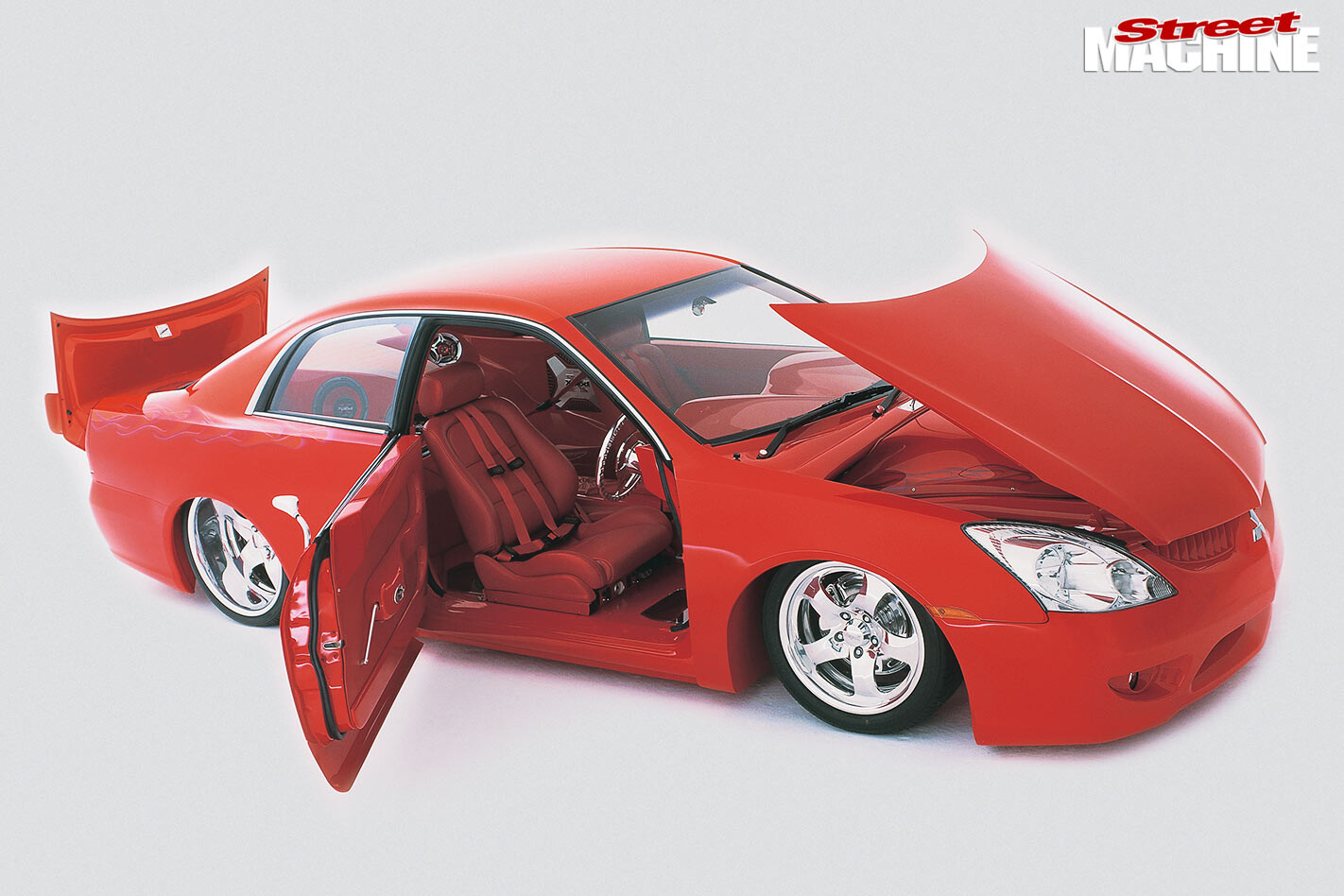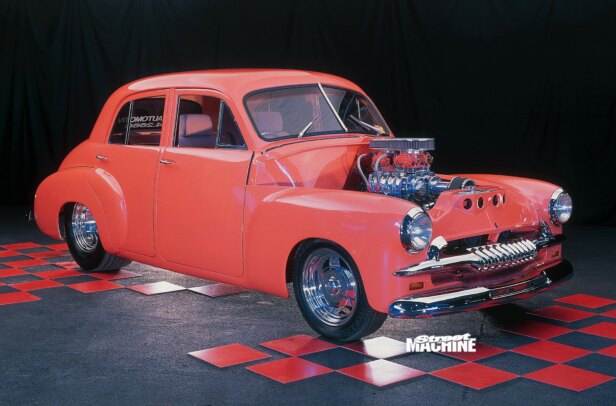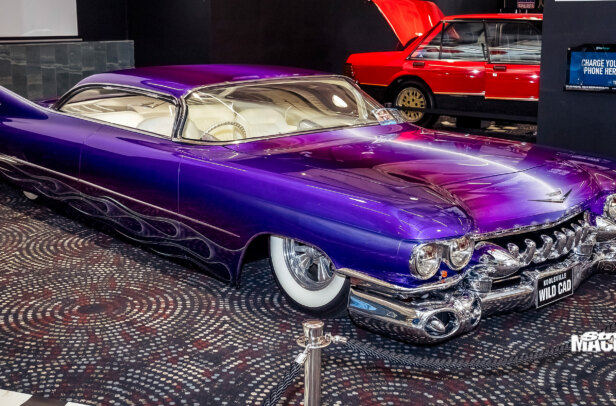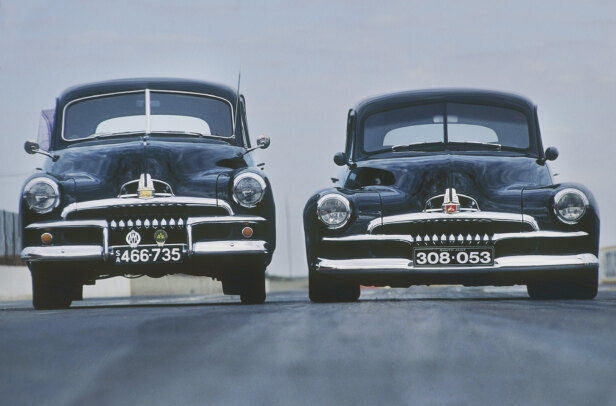This article on Darryl’s Magna was originally published in the October 2004 issue of Street Machine magazine
In my humble opinion, this is one of the most outstanding street machines ever crafted in this country. Now for the king-hit: it’s a Mitsubishi Magna.
It’s a project which has soaked up an intense four years in the lives of respected street machiner Darryl McBeth and his carefully hand-picked team.
Before we get into the how, there’s that question — why a Magna?
“Sony was talking about another car, after the Xplod Commodore wagon,” explains Darryl. “But they wanted a car for Auto Salon shows. I didn’t want to do one of those cars — a Japanese car or a Hyundai or whatever. I was stuffed there for a while … so I looked at a Magna.”
The plan included a V8 engine, a rear-wheel drive conversion using a fresh chassis, and scalpel-sharp innovation everywhere else. The result is a car welcomed at Auto Salon and street machine shows.
“When I thought of a Magna, I went straight to Mitsubishi,” recalls Darryl. He discovered the firm — with possibly the most staid image among Australia’s manufacturers — was open to suggestions to kick along its cred. The concept snowballed from there.
“Ryan Carter did some renderings,” says Darryl. “I went to Adelaide and had a meeting with the sales and marketing dude, Colin Sharp.”
Wild HR Giger (Alien)-inspired artwork by Matt Egan adorns most surfaces in the boot. The large cover serves multiple duties as a speaker box and cover for the fuel tank, pumps and filter, as well as the compressor and solenoids for the air bag system.
The response to that first meeting was positive. Darryl was invited for a second meeting with Mitsubishi and fondly recalls the event. “I thought I was meeting with one bloke,” Darryl says. “I opened the door and nearly died. I was in the big boardroom with 11 guys!
“There were questions coming left, right and centre. It was a blur, really. They wanted to know what they’d get out of it and how a V8 would fit in a Magna. These blokes didn’t know me from a bar of soap. About all they knew about our scene was the name Street Machine.
“They wanted to know why I chose a Magna instead of the more usual Holden or Ford and my response was: ‘That’s why — you’re asking questions about it, so it’s obviously raised your interest.’”
With those words, Darryl’s Magna successfully completed its first judging session. All Mitsubishi demanded was that, with the doors shut, the car was identifiably a Magna.
A few days later Mitsubishi rang to let him know there was a car waiting in Adelaide for him.
The donated Magna had 301km on it and, knowing it was getting a V8, Mitsubishi retained the engine and transmission. Darryl towed it to Melbourne but it wasn’t long before the first step of the four-year build began in Shepparton.
At Rod Lingard’s place (Hot Rod Trim) everything was stripped out — even the floor and firewall. As the car was to be rebuilt with a chassis and V8, Ian Eliason from Lilow Autotech was involved from day one.
“The chassis was designed from the ground up for the Magna’s dimensions,” explains Darryl. “The wheelbase is the same as a 1932 coupe and that’s what the chassis looks like.”
The entire chassis, including the tubular IFS, was fabricated by Ian Eliason at Lilow Autotech. Air bags are mounted upside down for a neater installation and can drop the car to 40mm ground clearance or raise it to 170mm for bush bashing
The shell was tacked over Lilow’s rod-style, 4×2-inch chassis, then towed to Ronny Zelukovic’s workshop in Orange, NSW, where it spent six months getting major body architecture changes. Ronny converted the Magna to two-door, completed the initial engine bay work, sheeted it underneath, added a tilt bonnet and boot lid, made the door skins, and filled in the rears. Then it went to Ray Alldrick’s True Colour Restoration in Bayswater North, Vic.
Where it was turned away.
Ray and Darryl chuckled about it but at first Ray didn’t want to take on the Magna. Darryl recalls: “He told me to F-off! ‘Not in this shop!’ he said, or words to that effect. I took it around on a trailer, he had a look and in it went!”
“I usually only do pre-’64 stuff,” laughs Ray. He guesses it took six to eight months, evolving the concept, making the boot lid match the bonnet. Then it was metal-finished, which took 10 weeks.
Seats started as frames brought in from the US but were soon cut and shut by master trimmer Ron Lingard to Darryl’s design. Completely custom shaped and swathed in red leather, the seats are much sleeker than the factory units
The whole car was lead-filled. Ray: “It’s better than filler. It’s what you use on quality rods.”
In this form the car was displayed at Summernats 16. Unknown to most there was a problem; Mitsubishi had just informed Darryl a new shape Magna was on the way. Before its debut, this Magna was obsolete.
No problems with back-seat drivers in this ride. Instead you’ve got 16 speakers mounted into the custom-formed MDF, smoothed over by the boys at True Colour Restorations and flamed by Matt Egan
So the car sat waiting for six months until details of the Magna’s facelift became known and the new parts were available. “We couldn’t get a thing until the car was released,” says Darryl, “Then we had to begin again.”
Although it looks similar, the latest Magna’s boot lid is different. As Darryl’s had already been flipped and internally panelled, a new skin had to be made. Retracing these steps took Ray three months.
A dummy engine had been installed and its cover created, but the new Magna’s nose was lower. The engine cover was de-crowned, but that wasn’t enough, so the engine had to be lowered by modifying the steering, notching the crossmember for the exhaust and remaking the engine mounts. A dry sump was part of the solution.
It was decided the black and blue in Ryan’s illustrations would look flat at indoor shows so a change was made. The red is — conveniently — a corporate colour both for Mitsubishi and Sony.
Ray explains: “I painted the orange turret first, which included the boot lid, then Matt Egan (Extreme Designs) came in and masked the flames. I back-applied the red up to the flames on the rear quarters, then Matt came back and finished the flames.”
Ray then applied finish paint to the underside and cleared the lot. “It’s kinda arse-about,” he says. “Most people would paint the car red then think about how to apply the graphics. The orange is more technical to paint. It can’t be touched up easily; it has to be right before you can go to the next step.”
The side glass was custom made by Roadrunner Windscreens. It’s legal, toughened glass and was sized up by Ray using rolled sheet steel to get the curve correct. Other standouts on the long list of body mods include rear-view mirrors from France which are also the door handles when you push down on them.
Prior to this, if anyone had said billet detailing and Dakota Digital gauges would work in the dash of a late-model Mitsubishi they’d have been laughed at but Darryl, Ray and Ronny nailed it. Most of the interior substructure is timber and fibreglass, with the basics done by a Sony team in Sydney to showcase the sound system components.
Sony gear includes four amps mounted in the floor under glass and two more in the side panels behind the seats, eight six-inch speakers and eight 10-inch subs. The seats feature retractable OMP harnesses imported from Italy. The dash panel, hand-formed to keep the Mitsubishi look, wraps into the doors and features a floating centre console.
Ray Alldrick fine-tuned the interior, ready for Rod Lingard’s trimming. The red leather was the final layer in one of the most astonishing interiors ever created. Stare at it and it dawns that the exterior graphics just appear to flow almost seamlessly into the interior.
Super-trick billet brake covers were designed and built by the guys at Lilow. Covering the Wilwood discs and matching beautifully with the billet calipers, they’re so cool that Boyd Coddington has ordered 10 pairs!
Mechanically, the Magna is a high-tech monster. A COME all-alloy block, based on Holden V8 architecture, is the centrepiece. COME also manufactured the Holden-style alloy heads and intakes. The engine fired into life last year with a tweaked Holden/Delco management system. It’s 400ci with a stroker crank and bigger bore.
Castle Auto Electrics in Castlemaine put together the fully polished and mandrel-bent 2.5-inch twin pipes. Featuring high-flow catalytic converters and 3.5-inch tube mufflers from Stainless Specialties, the system seems to float in mid air thanks to hidden mounts
Twin shotguns poke through an alloy orifice set in the factory Magna plastic bumper. Exhaust — big-bore cats and two Stainless Specialties mufflers — and all engine and general wiring is by Castle Auto Electrics.
Fully polished, all alloy COME engine measures 400 cubes and pumps out 385kW on the engine dyno. For an in-depth look at the engine
Behind the donk is an Impact Automatics GM TH400 three-speed auto with a TCE converter. The diff is a Morrison V8Supercar-spec, all-alloy nine-inch with Moser internals. Lilow four-link rear and Cortina rack and CRS drop spindles front feature suspension by The Airbag Man. Calipers are Wilwood Pro Street and the Wilwood rotors spin inside Lilow-machined shrouds. Rubber is Yokohama on a one-off set of 20- and 17-inch Bonspeed wheels from Wheelboyz. Darren Carter added the final touches, machining most of the billet bits in the running gear.
This is the short story. Darryl’s tightly written notes fill five pages. To truly take it all in takes days.
THE MAN HIMSELF: DARRYL McBETH
Melbourne-based Darryl is best known for his supercharged blue-then-orange sherbet 1995 SMOTY-winning FJ Holden (above, which he tied for the trophy with Howard Astill’s Falcon hardtop) and his two-door, low-lid, delivery van-style, Sony Xplod VS Commodore wagon. Both have been Street Machine cover cars and inspiration to thousands of show-goers Australia-wide in the past decade. Darryl has sold the FJ — the only component he retained was the steering wheel, now in the Magna — and the VS Commodore, to burnout enthusiast James Scarlett. So what plans for Darryl McBeth, car-crafter extraordinaire?
“This top-end of the scene is getting very expensive,” he concedes. “It’s an incredible amount of time and effort. I reckon I’ve had my time. It’s time to pass the mantle to someone else.”
DARRYL’S MAGNA IN THE BUILD:
1. Pillars were swapped left to right to allow left rear door to become front right. This meant factory hinges and latches (an engineer’s requirement) could be used to create suicide opening doors.
2. Custom steel dash was modelled on factory unit, but was mirrored so that driver and passenger sides matched. This will make life easier for a LHD conversion if the car ever gets sold in the US.
3. The only Morrison diff NOT in a V8Supercar is mounted using hot rod-style four-bars and features billet Moser axles, Wilwood four-spot calipers and is spun by a four-inch aluminium Morrison tailshaft.
4. Entire front clip is welded into one piece and is completely seamless. Apart from the front and rear screens and the grille insert, there isn’t much that hasn’t been chopped, smoothed or changed.
DARRYL McBETH
2001 MITSUBISHI MAGNA
Colour: House of Kolor Blood Red and Ultra Orange
POWERPLANT
Engine: COME all-alloy V8
Capacity: 400ci
Valves: Ferrea 2.05-inch inlet, 1.6-inch exhaust
Pistons: 4.125-inch KB hypereutectic
Conrods: COME, forged 5.85-inch
Crank: COME 3.75-inch iron stroker
Cam: COME hydraulic roller
Manifold: COME twin-throttle
ECU: COME/Delco
Exhaust: Castle Auto Electrics, with Stainless Specialties mufflers
Radiator: Alloy by Race Radiators
Sump: Dry sump system
TRANSMISSION
Converter: TCE Big Mac
Gearbox: TH400 three-speed auto
Tailshaft: Moser
Diff: V8Supercar-spec, alloy nine-inch
UNDERNEATH
Chassis: Lilow custom
Front end: Lilow rod-style IFS with air bags; Cortina rack
Rear end: Lilow four-link with air bags
Brakes: Wilwood Pro Street four-spots front and rear over Wilwood rotors
ROLLING STOCK
Wheels: Bonspeed, 17×7 (f), 20×11 (r)




Comments